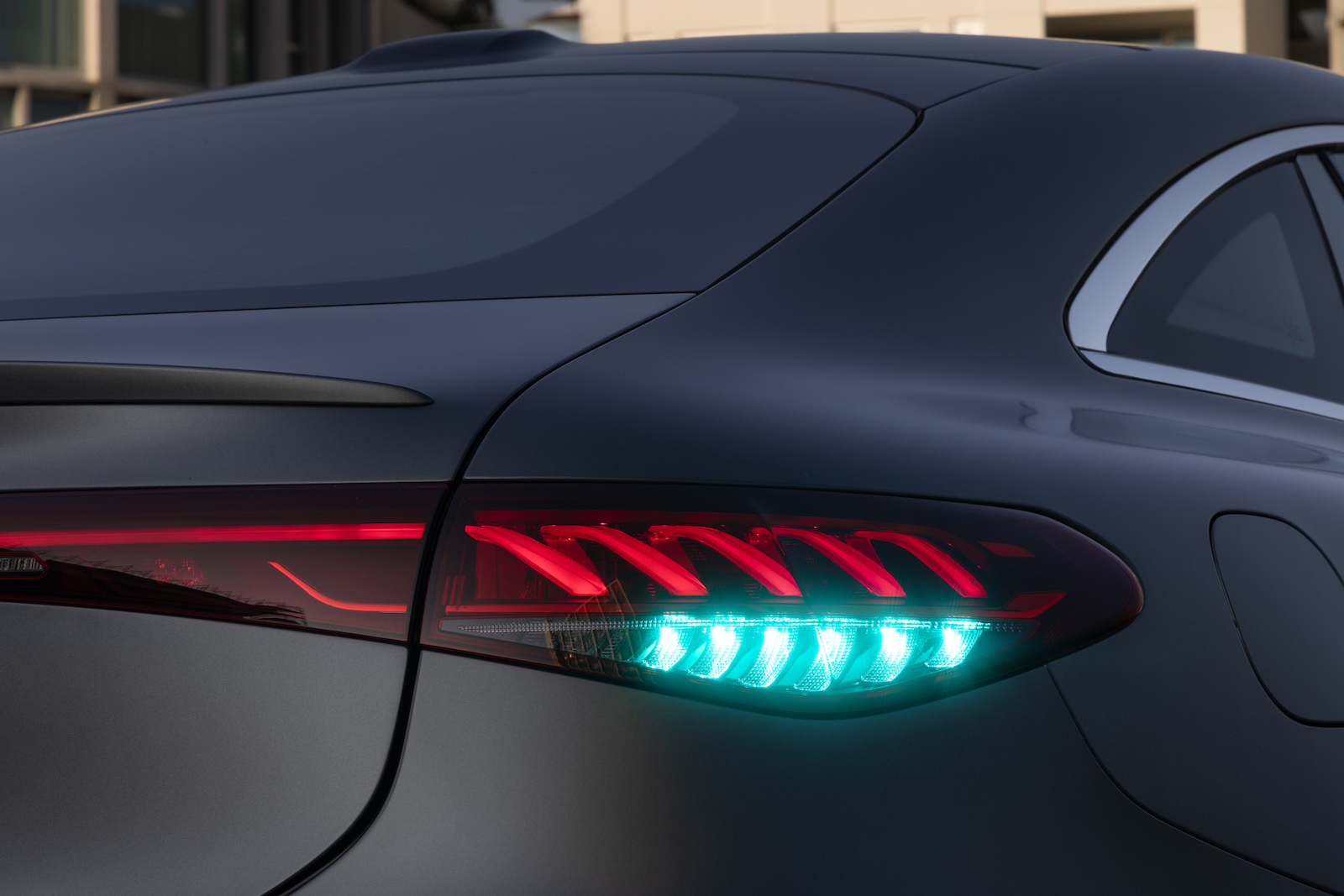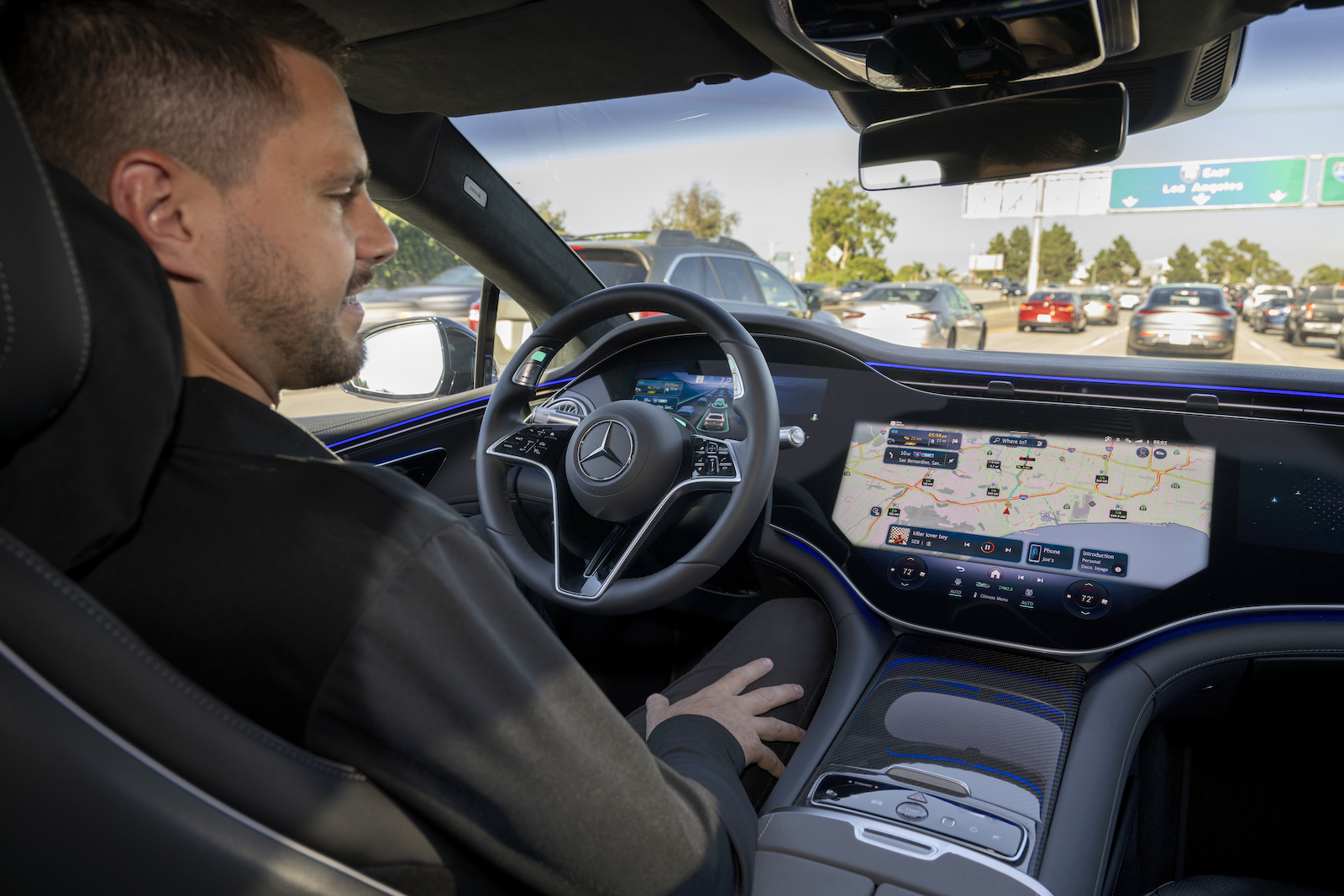If you’re like most motorists, you’d like to be doing pretty much anything else rather than having to fight traffic on your daily commute. Now you can. At least if you live in California or Nevada.
Oh, and did we mention you’ll need to be driving a Mercedes-Benz EQS?
The German automaker has finally gotten all the pieces in place permitting it to launch the world’s first Level-3 autonomous driving system.
Yes, there are a handful of systems that let you go hands-free, like General Motors’ Super Cruise and Ford’s BlueCruise (though not Tesla’s Autopilot which still requires you to keep hands on the wheel).
But they all mandate you to keep an eye on the road and be ready to take back control at a moment’s notice. Mercedes’ Drive Pilot goes the next step. Stuck in traffic? No problem. You’ll be able to make calls, check text messages, even watch videos on your smartphone, iPad or the EV’s infotainment screen.
A “technological game-changer”
“Drive Pilot is a technological game changer and incredible leap forward in the pursuit of conditionally automated driving,” said Dimitris Psillakis, president and CEO of Mercedes-Benz USA. “This ground-breaking system reinforces our intention to lead in safety and technology, while giving precious time back to our customers during heavy traffic situations.”
Actually, Mercedes already offers Drive Pilot in Europe. Here in the States, however, it had to wait for approval from various state and federal regulatory bodies before it could add the system to its list of options.
It also had to start rolling out versions of the EQS equipped with lidar, a laser technology that leapfrogs the current radar and camera systems already installed on the EV flagship. Those other systems will remain in place as part of a redundant “sensor fusion” that is “key for safe automated driving for level 3 and beyond,” said Markus Schäfer, Mercedes‑Benz Group’s chief technology officer.
Pricing
The key advantage of lidar is its ability to see the world in highly detailed 3D. The images it captures will be compared to high-definition onboard map data. Where conventional mapping systems are accurate to within several feet, lidar increases accuracy to a matter of inches.
Drive Pilot will start its rollout on the EQS. It will be added to the Mercedes S-Class later in the 2024 model year and then Mercedes plans to introduce it on additional products in the coming years. The initial price will be $2,500, “with other pricing options to be announced at a later date,” the automaker said in a news release.
Limitations
Don’t expect to be able to use Drive Pilot all the time, however. For now, at least, it’s being electronically limited to no more than 40 mph on interstates and some other divided highways — though Schäfer recently told Headlight.News the goal is to eventually raise that speed and permit Drive Pilot to be used under routine driving conditions.
Nevada set relatively few strictures on the use of the new system. California’s Department of Motor Vehicles is being a bit stricter, requiring motorists to first watch an instructional video before Mercedes remotely activates the technology.

To make sure police and other motorists know when a vehicle is operating in Level 3 mode, Mercedes has added turquoise-colored Automated Driving Marker Lights to vehicles.
For its part, Drive Pilot will only be operable at relatively low speeds — up to 40 mph — meaning it will primarily assist drivers facing heavy traffic on interstates and some other divided highways. But that could prove quite popular with motorists in many parts of California where average speeds can dip into the single digits during rush hour.
The system is designed to recognize and respond to traffic signals and signs. It also keeps a digital ear out for emergency vehicles and can maneuver out of the way to let them pass. Additional audio sensors will disable the system in bad weather.
Watch a video – but don’t fall asleep
Drive Pilot lets a motorist shift attention away from the road — as long as they remain awake and alert. That means they can watch videos or text. They won’t be able to take a nap, however, or jump into the back seat — as videos have shown Tesla owners doing while operating on its Autopilot and Full Self-Driving systems.
Mercedes has taken a number of steps to ensure Drive Pilot doesn’t malfunction, among other things installing backup sensors and dual computer processors, one reserved as a fallback if the primary system fails.
The automaker aims to prevent the embarrassing failures linked to Tesla’s semi-autonomous technologies which have come under repeated investigation by the National Highway Traffic Safety Administration and the National Transportation Safety Board.
To make sure police and other motorists know when a vehicle is operating in Level 3 mode, Mercedes has added turquoise-colored Automated Driving Marker Lights to vehicles equipped with Drive Pilot. Though not yet required in the U.S., this approach is being championed by the safety advocates, the Society of Automotive Engineers and other autonomous driving proponents.
What it’s like to use Drive Pilot
I had the opportunity to test out Drive Pilot during a visit to Mercedes’ main test track an hour outside Stuttgart, the automaker creating a realistic rush hour experience.
While a driver can take their eyes off the road for a while, Drive Pilot still monitors the motorist, among other things, to make sure they are still alert. Fall asleep and it will buzz you back to consciousness and then, if you fail to respond, the vehicle will slow down, pull over and even call for emergency responders.
When an emergency vehicle approached from behind, my test vehicle responded by moving towards the right of its lane, providing a path for the ambulance to pass through. A moment later, as a car in front of me suddenly shifted into reverse to try to change lanes Drive Pilot blew the horn, completely on its own, alerting the other driver to stop.
Again and again, the system responded to any number of problems one routinely runs into during a morning’s commute. While I set out on the drive with a clear sense of trepidation, I grew increasingly comfortable as Drive Pilot handled those situations as well as any human driver would.
Other systems to follow
Both GM’s Cruise LLC and Google spinoff Waymo have gotten the go-ahead to operate completely driverless ride-share vehicles in San Francisco and a few other places. Drive Pilot gives Mercedes the first-mover advantage in the retail automotive market, however.
But it won’t be alone for long. Tesla CEO Elon Musk has repeatedly promised a full hands-free version of the FSD system — though that launch has been delayed for several years.
Volvo has promised to come up with similar capabilities on some of its future EVs. As with the Mercedes EQS, its new EX90 will feature lidar, which many experts believe will be essential to fully autonomous driving.
EV maker Lucid has promised similar upgrades to its already lidar-equipped Air sedan. And GM is believed to be moving in this direction with the Ultra Cruise system that will go a step further than today’s Super Cruise technology.





0 Comments